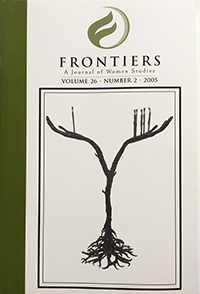Christmas 2004 and I find myself transplanted from my home in Melbourne, Australia to the chilly high desert of Albuquerque, New Mexico for the holidays. Here I find myself, by way of distraction, contemplating the work of American artist Jennyfer Stratman. In a strange way, my own temporary re-location brings with it a greater understanding of Stratman’s work.
Phoenix-born and Melbourne-based Stratman is a young artist whose life and work have adapted through migration. Her recent work, shown here, follows on from earlier interests in botanical and biological forms. Initially using cast body parts and plant forms to translate personal comments about her environment, sexuality and community, Stratman has developed a visual language that intimately communicates a unique perspective on common human experiences.
In recent years, Stratman has brought to her work references to the migrant experience. Since moving to Australia in 2001, she has established studios in Melbourne and Phoenix. The effort of transplanting and maintaining her artistic practise in both countries has been a struggle uniquely depicted in her work. Stratman’s struggle in assimilating with her new environment echoes strongly with American and Australian audiences, as both countries are keenly aware of their own migrant histories. And like a migrating bird, Stratman makes regular journeys from one country to the other, collecting influences and experiences along the way.
Stratman has cited the intensely personal expressions of artists such as Louise Bourgeois, Ana Mendieta and Frida Kahlo as influential in her own development. Certainly, she pours her own potent emotions into depictions of people lost, unable to communicate or struggling to liberate themselves of earthly burdens. Stratman’s main communicative method is empathy. Her figures are dynamically placed in their surroundings, attempting unification where it is blocked, striving for movement or extension where it is grounded. We recognise their need to manoeuvre within and gain control over their given environments as being a common human response to adversity.
Stratman approaches her work with sparsity of detail; her figures are bare sketches, yet with the subtlest inflection they indicate intense emotions such as love, yearning, loneliness or kinship. There is a delicious tension between the femininity of her subjects and the masculinity of her techniques. Cast or fabricated patinated metals and scorched wood feature frequently as materials in Stratman’s free-standing and wall-mounted sculptures. She destroys the unblemished surface of her chosen medium and burns into it a new and far more complex imagery.
The Southwest of Stratman’s personal history is ever-present in her work, although always through subtle and indirect references. However, in Wandering Star, the flattened mesa-tops of the landscape and the swirling heatwaves of the desert in summer are present as reminders of her origins. The title, however, leads us to understand that the Wandering Star is moving away from the familiarity of this landscape into one not shown but implied.
These quietly controversial works serve to remind us that figurative sculpture continues to play a vital role in contemporary art, despite often being overshadowed by more conceptual and attention-grabbing work. These sculptures ask that we, as human beings, work harder to communicate with each other, to express our emotions and to respect the place from which we came and where we are now.
Lisa Richards
Lisa Richards is a Melbourne-based, London-born international citizen, with family in New Mexico. She graduated in History of Art at Manchester University, UK, in 1994 and worked as an arts manager for several London based organizations. In 2001 she migrated to Melbourne and has been Gallery Manager for Christine Abrahams Gallery over 3 years. She has also served on the Board of Management for the Contemporary Sculptors Association, Melbourne. Her next project will be a Master of Visual Culture, primarily researching International artist workshops.
